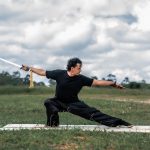In the world of combat sports, the measurement of reach holds paramount importance. This insightful article delves into the precise techniques used to measure reach in the UFC, specifically focusing on the intriguing interplay between wingspan and leg reach.
Understanding the nuances of these measurements is crucial for both fighters and fans who desire mastery in the octagon. From the step-by-step process to the strategic advantages, this article uncovers the technicalities that contribute to a fighter's success.
Key Takeaways
- Reach, also known as wingspan or arm span, is the length from the longest finger on one hand to the longest finger on the other hand.
- To accurately measure reach in the UFC, fighters go through a three-step process that includes warming up muscles, removing upper body clothing, and standing against a wall with arms raised perpendicular to the body.
- Long-reach fighters in the UFC have the advantage of controlling the striking range, effective probing, and capitalizing on opportunities against lunging opponents.
- Reach in the UFC is measured from the longest finger on one hand to the longest finger on the other hand, while leg reach is measured from the top of the hipbone to the heel.
The Importance of Measuring Reach in the UFC
One of the key aspects of analyzing a fighter's potential success in the UFC is the measurement of their reach. Reach plays a crucial role in MMA fights, and analyzing reach advantage can provide valuable insights into a fighter's strategy and chances of victory.
The importance of reach in the UFC cannot be understated, as it directly affects a fighter's ability to strike and defend against their opponent. A longer reach can give a fighter a significant advantage in controlling the striking range, keeping their opponent at a safe distance, and capitalizing on counterpunching opportunities. It also enhances takedown defense and offensive wrestling, allowing fighters to maintain control and execute submissions from advantageous angles.
While reach is not the sole determinant of success, its analysis is essential for understanding a fighter's potential strengths and weaknesses in the octagon.
Step-by-Step Guide: Measuring Wingspan for UFC Fighters
When measuring the wingspan for UFC fighters, it is important to follow a step-by-step guide to ensure accurate and consistent measurements. The process begins with the fighter warming up their muscles through light exercise and stretching, focusing on the arms and shoulders. Upper body clothing should be removed to prevent interference with the measurement. Female fighters can wear a sports bra for shoulder and arm flexibility.
Once prepared, the fighter stands as straight as possible with their back and heels against the wall. They raise their arms perpendicular to their body at shoulder height, maintaining a 90-degree angle between their arms and body. The fighter then places their palms against the wall, facing outwards, for the most stretched but comfortable reach. Once in position, the points on the wall from the longest fingertip to fingertip on each side are marked. A tape measure is used to measure the distance between the marks, which is recorded as the fighter's reach in inches.
The wingspan, or reach, of a fighter can have a significant impact on their performance in striking and grappling. A longer reach provides several benefits in the UFC. It allows fighters to control the striking range and keep their opponents at a safe distance. Long-reach fighters can effectively probe and capitalize on opportunities against lunging opponents.
In terms of grappling, a longer reach aids in takedown defense, as it gives fighters more time to sprawl or snuff their opponents' takedown attempts. It also helps with offensive wrestling, as fighters can reach around their opponents with ease, particularly in double-leg takedowns. Additionally, a longer reach provides an advantage in finding submissions at angles that shorter reach fighters may struggle with. For example, fighters with longer reach can apply darce or anaconda chokes more effectively. In jiu-jitsu and submission attempts, long leg reach allows fighters to attack with triangle chokes or armbars.
Understanding Leg Reach Measurement in the UFC
The leg reach measurement in the UFC is an important factor in assessing a fighter's physical attributes and potential advantages in striking and grappling. While reach is commonly associated with the length of a fighter's arms, leg reach plays a crucial role in determining a fighter's ability to strike, defend, and execute grappling techniques.
Common misconceptions about leg reach include focusing solely on arm reach and underestimating the impact of leg reach in combat sports. Fighters with a longer leg reach have several advantages, such as the ability to control distance, execute effective kicks, and defend takedowns by keeping their opponents at bay. Additionally, long leg reach can enable fighters to apply submission holds from unique angles and enhance their defensive capabilities.
Understanding leg reach measurement is essential for both fighters and fans to comprehend the dynamics of a matchup and appreciate the strategic choices made by athletes inside the Octagon.
Factors to Consider: Wingspan Vs. Leg Reach in MMA
A crucial factor to consider when analyzing a fighter's physical attributes in MMA is the comparison between their wingspan and leg reach. The wingspan, or reach of the arms, plays a significant role in a fighter's striking ability and defensive techniques. On the other hand, leg reach affects a fighter's takedown game and ground control. Let's take a closer look at the advantages of a long wingspan and the impact of leg reach on takedowns.
Advantages of a long wingspan:
- Control of striking range and keeping opponents at a safe distance.
- Effective probing and counterpunching.
- Improved takedown defense by creating distance and denying opponents the opportunity to shoot for a takedown.
Impact of leg reach on takedowns:
- Long leg reach allows for easier offensive wrestling, particularly in double-leg takedowns.
- Enables fighters to attack with submissions such as triangle chokes and armbars.
- Aid in defense with upkicks and a closed guard when on the back.
To illustrate this further, here is a table showcasing the advantages of a long wingspan and the impact of leg reach on takedowns:
| Advantages of Long Wingspan | Impact of Leg Reach on Takedowns |
|---|---|
| Control striking range | Easier offensive wrestling |
| Effective probing and counterpunching | Ability to attack with submissions |
| Improved takedown defense | Defense with upkicks and closed guard |
Understanding and analyzing the interplay between wingspan and leg reach is crucial in evaluating a fighter's overall skills and potential advantages in the Octagon.
Maximizing Reach Advantage in the Octagon: Tips and Strategies
How can fighters effectively maximize their reach advantage in the Octagon? Having a longer reach can provide fighters with a significant edge in their matches.
To make the most of this advantage, fighters can employ various tips and strategies to utilize their reach effectively. One key strategy is to maintain distance by using long jabs and kicks to keep opponents at bay. This allows fighters to control the striking range and minimize the chances of getting hit.
Additionally, fighters can use their reach to execute effective counterattacks, capitalizing on the distance to strike back when their opponents lunge forward.
Another tip is to focus on takedown defense, using the reach advantage to sprawl or stuff takedown attempts from a distance.
Conclusion
In conclusion, accurately measuring reach in the UFC is essential for fighters to develop effective strategies and for fans to understand the dynamics of the sport.
Wingspan and leg reach play significant roles in a fighter's performance, providing advantages in striking range, probing, and defense.
By understanding the step-by-step process of measuring reach and maximizing its advantages, fighters can enhance their chances of success in the octagon.
Reach may be just one factor, but its impact on a fighter's success should not be underestimated.
- 15 Best Martial Arts Weapons (Fighting & Training) - October 14, 2024
- Is Fencing a Martial Art? (Yes, 4 Reasons Why) - October 14, 2024
- 7 Best Martial Arts for Self-defense Ranked (Highly Effective) - October 14, 2024










